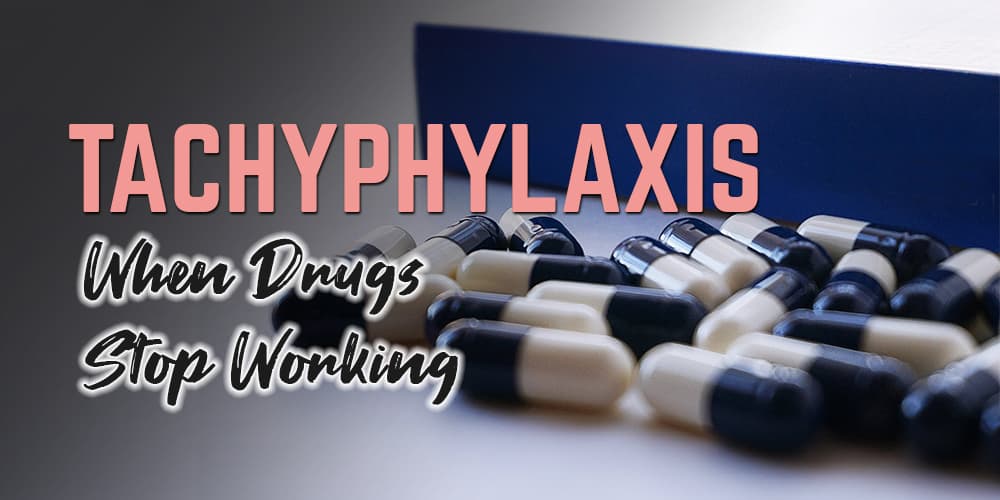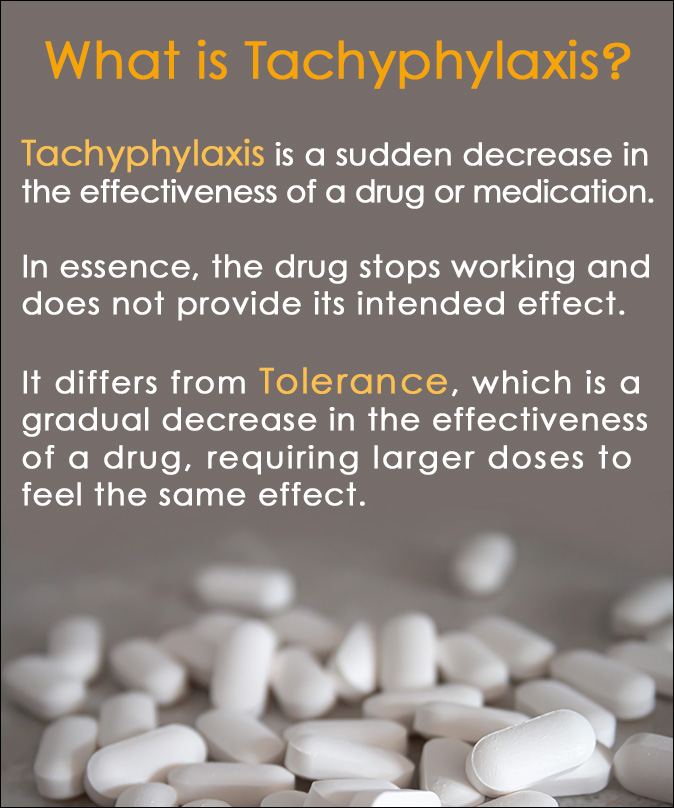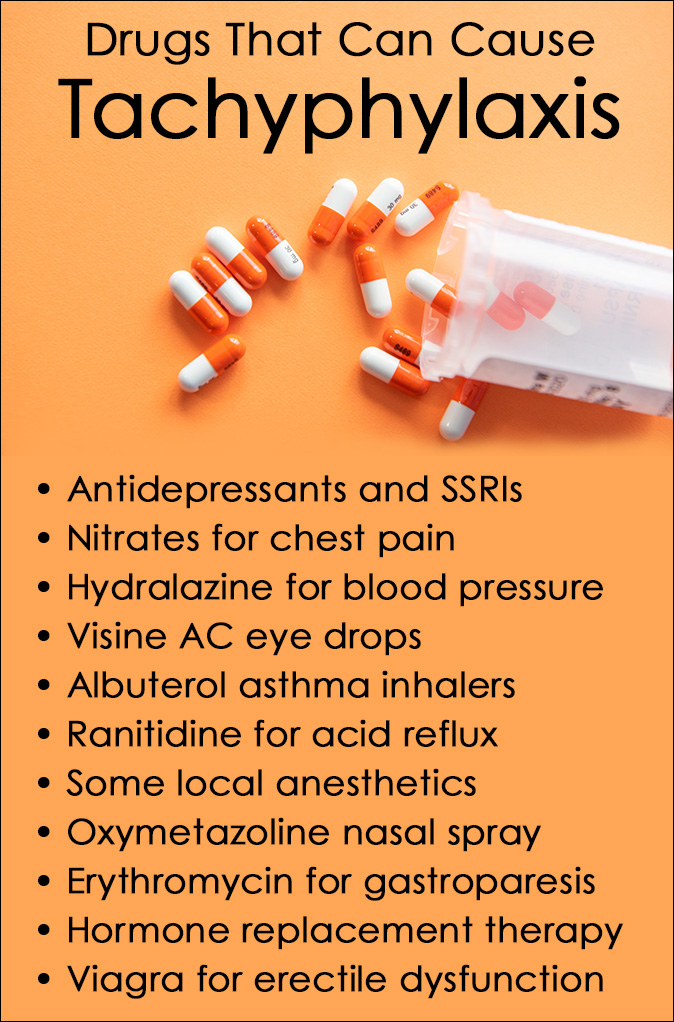
When medication effectiveness is reduced or stops working altogether, it’s common to think it may be caused by a drug tolerance, when in fact, it might be caused by Tachyphylaxis.
This condition can occur with a wide range of prescription and over-the-counter drugs, including antidepressants, decongestants, eye drops, nitrates, and local anesthetics.
Even though Tachyphylaxis shares many similarities with drug tolerance, they have unique differences so it’s important to understand the causes and symptoms for each one.
What is Tachyphylaxis?
A simple Tachyphylaxis definition is “a sudden decrease in the effectiveness of a drug.”
It is often confused with drug tolerance because the symptoms are similar, but the main difference is usually identified by the speed of onset.
Tachyphylaxis can occur after the first dose or repeated doses and may be caused by a decrease in the body’s sensitivity to the effects of the drug.
In essence, a drug or medication stops working as as intended even though an individual is taking it as prescribed.
An example of tachyphylaxis is taking an antidepressant that initially works well to manage the symptoms of depression but quickly stops working and the symptoms return.

What Causes Tachyphylaxis?
There are number of factors that can cause tachyphylaxis and most are related to a person’s biology and the properties of the drug being used.
One of the primary causes is receptor desensitization, which is a form of down regulation to an agonist.
This occurs when a drug receptor in the body triggers cellular changes that decrease the responsiveness of the receptors. Over time, this can result in reducing the medication effectiveness of a drug.
Sometimes, receptor desensitization is due to skipping doses or taking a drug inconsistently. If the body doesn’t receive a proper amount of the drug or at the scheduled time, it is unable to maintain the correct pharmacological effect.
Another common cause of tachyphylaxis is related to the way the drug or medication is administered. The dose, frequency of use, and duration of use all play a role in the development of the condition.
In some cases, long-term use and high dosages can increase the likelihood of tachyphylaxis, although not always, as it can also occur after the first use of a drug.
Certain drug properties may trigger tachyphylaxis for some individuals, and these could be related to the amount of drug absorption in the system, or a duration of use that is too short to provide a therapeutic effect.
Tachyphylaxis vs Tolerance
It’s easy to confuse tachyphylaxis vs drug tolerance because they both involve a decrease in the response or medication effectiveness of a drug, but they are two different conditions.
The key difference between drug tolerance and tachyphylaxis is the timeframe of onset.
A drug tolerance develops gradually over time with prolonged use as the body becomes accustomed to the effects. When this happens, it requires higher doses of a drug to feel the same effects as when a person first started using it.
Tachyphylaxis occurs much more quickly and is sometimes noticeable with the first doses of a drug.
Another difference is recovery of tachyphylaxis can happen more quickly than tolerance by stopping the use of the drug that is causing the symptoms.
Reversing the effects of tolerance is not as easy and can take a much longer period of time depending on the type of drug used, the dose, and duration of use.
Tolerance is related to dependence and addiction, while tachyphylaxis does not share the same connection.
When a person develops a tolerance and dependence to drugs and stops using them, they may experience withdrawal symptoms that do not appear with tachyphylaxis.
Acute withdrawal is usually short-lived, although post acute withdrawal syndrome symptoms can last for months or longer depending on the type of drug.
Symptoms of Tachyphylaxis
The symptoms of tachyphylaxis can vary depending on the type of drug being used and the condition it is intended to treat.
The most common symptom is the drug stops working and the condition it is prescribed to treat returns or becomes worse.
For example, if an individual is taking medication to lower blood pressure and develops tachyphylaxis, the medication quickly stops working and their blood pressure returns to the same levels or higher than before they started taking the drug.
Tachyphylaxis and antidepressants occurs due to receptor desensitization. Many SSRIs increase serotonin levels in the brain to overcome depression, but if the drugs stop working, a person’s depressive symptoms quickly return.
As mentioned previously, the onset of tachyphylaxis happens very quickly and there is a rapid decrease in medication effectiveness, usually within a few doses. This is a major difference between tachyphylaxis and drug tolerance.
Drugs That Can Cause Tachyphylaxis
Certain medications are known to cause tachyphylaxis, including nitrates for chest pain, Hydralazine for high blood pressure, oxymetazoline (Afrin) nasal spray for congestion, and some antidepressants.
It’s important for doctors and patients to discuss the signs and symptoms of tachyphylaxis to be aware of when taking prescription medications or over-the-counter drugs.

Common Examples Include:
- Antidepressants and SSRIs
- Nitrates or Nitroglycerin for chest pain
- Hydralazine for high blood pressure
- Visine AC eye drops
- Albuterol asthma inhalers
- Ranitidine for acid reflux
- Some local anesthetics
- Oxymetazoline or Afrin nasal spray
- Erythromycin for gastroparesis
- Hormone replacement therapy for menopause
- Viagra for erectile dysfunction
These are some of the most examples of drugs that can cause tachyphylaxis. For anyone noticing a rapid return of symptoms after taking these medications, it’s important to speak with a doctor at the first signs.
Treatment Options
Medications are prescribed by doctors or purchased over the counter to treat a wide range of health conditions. Most of the time they work when used as directed, but when they don’t, it’s necessary to make changes.
Being able to identify the signs and symptoms of tachyphylaxis is crucial for finding effective treatment options.
Several approaches include:
Prescribing a different type of drug that offers a similar medication effectiveness for a particular condition can be helpful. Some doctors will substitute an SNRI for antidepressant SSRIs to see if that resolves the issue and stabilizes depression symptoms.
Increasing the dose of the current medication can be effective for treating the rebound symptoms that can occur due to tachyphylaxis.
If several different types of medications lead to tachyphylaxis or fail to treat the symptoms of a condition, a non-medication alternative may be required.
TMS Therapy has shown to work for some people with treatment resistant depression and it does not require the use of prescription medications.
Decreased medication effectiveness from Tachyphylaxis receptor desensitization can be challenging, so it’s important for patients to speak with their doctor as soon as prescription drugs stop working.
Related Posts
- When Did the War on Drugs Start?
Many drugs that are currently illegal, such as opium, cocaine, and psychedelic drugs, have been…
- Top 10 Worst Drugs and Most Dangerous Drugs
Americans are more likely to die from drug abuse and misuse than any other preventable…
- Long Term Side Effects of Drugs and Addiction
There's a lengthy list of long-term side effects of drugs and addiction that affect both…
